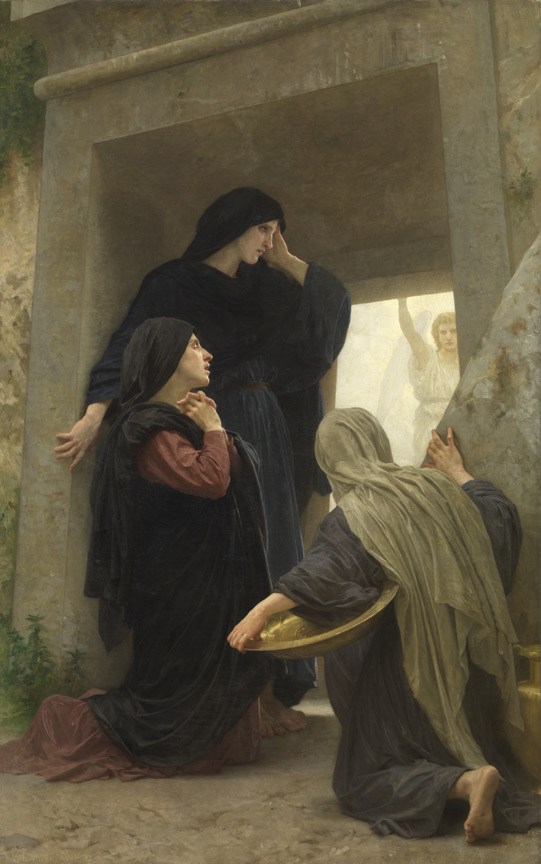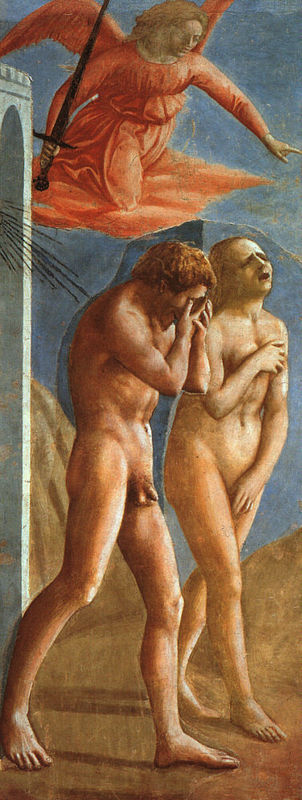Bouguereau’s Rendition of the Empty Tomb reflects Mark’s Ambiguity
The book of Mark is recognized as the first account of Jesus to have been written. Mark is different from the other gospels – Mathew, Luke, and John – as Mark has two alternative endings. The two added are vastly different from the first as Mark’s first conclusion is open-ended. In the first ending, three women visit Jesus’ tomb and encounter a man in a white robe. They learn that Jesus roze from the dead but because of the utter shock they underwent, they remained silent:
“As they entered the tomb, they saw a young man, dressed in a white robe, sitting on the right side; and they were alarmed. But he said to them “Do not be alarmed; you are looking for Jesus of Nazareth, who was crucified. He has been raised; he is not here. Look, there is the place they laid him. But go, tell his disciples and Peter that he is going ahead of you to Galilee; there you will see him, just as he told you.” So they went out and fled from the tomb, for terror and amazement had seized them; and they said nothing to anyone, for they were afraid”
In the alternative endings, the women do deliver the news of Jesus’ resurrection to his disciples. This compels us the reader to wonder why were the 2 later endings were added. It is worth noting that the first ending is more ambiguous about Jesus’ identity as the Messiah. We don’t know if the man in the robe is an angel. Additionally, we have no idea of Mark got the news of Jesus rising from the tomb since the women never shared what they learned according to the text. The other two endings are an attempt to “fix the ending” as it was based on established Christian doctrine. They include the women at the tomb informing the disciples of what they had seen and Jesus being the Messiah is more certain. The other gospels, being afterlives of Mark, follow this trend.
I argue that Bouguereau’s illustration of the empty tomb is closest to Mark’s original ending as it maintains the ambiguity of the text.

Medium – Oil
William Adolphe Bouguereau
1890
From Dark to Light
In the foreground of Bouguereau’s piece, the color scheme includes primarily dull tones. For example, in details, 1 – 3, a deep black colors the women’s clothes, as the tomb and ground are illustrated by faded browns and gray. Bouguereau utilized hues that are often associated with a depressing mood. This parallels the emotional state of the women. In the final scenes of Mark, all of Jesus’ disciples were mourning after the crucifixion. Thus when the women visited the tomb they were not only shocked by the news of Jesus’ resurrection but also the unexpected presence of the man in a robe. Bouguereau’s depiction of the ending of Mark however brings focus to the humanity of the women who were affected. The overwhelming distraught emotions portrayed through the darkened color gradients portray the fear held by the women. This reinstates the uncertainty present in the text of Mark as the news of the empty tomb wasn’t suddenly received with absolute joy. Instead, the “terror”, fear, and “amazement” of the event is captured.
Within details 4-5, the man in the robe is present. Displayed with light creams and whites, the unidentified man and their space are symbolic of the good news. This shows us, the spectator, that the background of the work aims to depict the holiness and goodness of Jesus’ resurrection. However, it must be noted that this section is overpowered by the large scale of dark gradients that accompany the saints. It may appear that Bouguereau may be taking away attention from the significance of the empty tomb, however, he rather compels us to notice all aspects of the event. Instead of fully focusing on the good, we are able to notice and sympathize with the shock of the women. This shock allowed us to grapple with how the news of the tomb was received. The effect of the event on the women compels us, the spectator, to draw our own conclusions about Jesus as we face the implications of the ambiguity of the text. In some ways, this spotlight on the unnamed women serves as female empowerment. Given that women were overlooked and all of Jesus’ disciples were male, it is astonishing that it was acknowledged the finders of the empty tomb were women.
Space and Perspective

Since the women take up about 80% of the painting our attention naturally will be drawn to the them. Thus, Bourgeois’ use of space brings us to give attention to not what the man is doing but the reaction of the women. Additionally, the small space the man occupies also puts forward a theme of separation. The small window the man occupies that represents goodness and holiness is disconnected from the world of utter shock the women exist this emphasizes the importance of noticing the fear the women underwent. Fear is an emotion that can be often associated with being unsure, which is a present theme within the text of Mark. We must notice though that Mark and Bouguereau do not shed a bad light on being unsure. Instead, they respect this emotion as it challenges the spectator to explore the texts for themselves. In some aspects, this ambiguity of the text is extremely powerful when considering the certainty the other gospels put forward, as it calls readers to juggle with faith. Faith being an important tenet in all gospels as they all present the idea of believing in Jesus.
Artistic Commonalities
Bouguereau wasn’t the only one to have captured the humanity of biblical figures within his works. Another example where an artist who captured the emotional repercussions of biblical events, is Masaccio’s rendition of Adam and Eve’s Expulsion from the Garden of Eden.

Like Masaccio, Bouguereau portrayed the emotion of biblical figures to help spectators think critically about the text. For Mark, it was the ambiguity of Jesus’ identity and for Masaccio, it was the repercussions of disobeying God. Interestingly, both artists did include their own beliefs that differ from the original text. In the post, it is shown Masaccio’s work is critical of God’s actions, which criticism of God is in no way present in the text. While in Bouguereau’s work, it is clear that he believes the man in the robe is an angel, shown by the individual being in all white with wings makes him appear divine. This influence of personal belief isn’t uncommon in Afterlives of texts. Afterlives can often be similar to the original text in many ways but also different. Afterlife authors view the original text through their own lens which gives a sort of individuality to the work created.